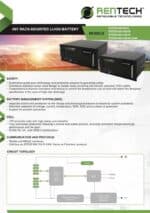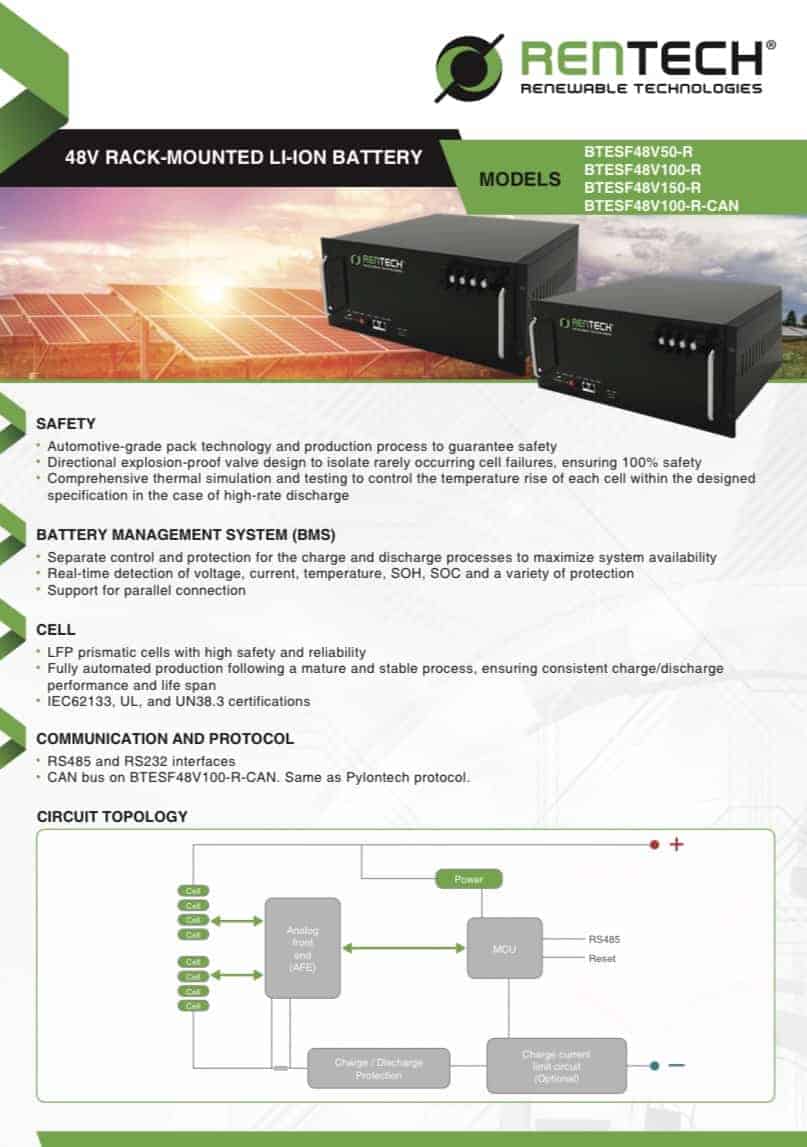



Singo 2000 Pro Portable UPS Power Station Special
R22,930.00 Original price was: R22,930.00.R12,995.00Current price is: R12,995.00. (incl. VAT)

Hubble X-101 Lithium Battery 5.5kWh 51V – Rack Mountable
R20,950.00 (incl. VAT)
Rentech 51.2V 100Ah LiFePO4 Battery with CANBUS – (5.12kWh)
R25,995.00 Original price was: R25,995.00.R19,500.00Current price is: R19,500.00. (incl. VAT)
This Rentech 51.2V 100Ah LiFePO4 Battery with CANBUS – (5.12kWh)
- Lithium-Iron Phosphate Battery with 6000 cycles @ 80% DoD
- Built-in Battery Management System
- Over voltage protections system
- Low voltage protection system
- High temperature protection
- Safe and Reliable
Out of stock
Do you need assistance selecting the right product? Contact us today.
Neil: +27 72 690 2734
Description
This series of rack-mounted Lithium-ion batteries are designed for the solar / backup power market. This series combines safe and reliable LFP prismatic cells with dedicated BMS to guarantee high reliability, safety and scalability.
This product can be installed in a 19” or 21” standard cabinet or rack.
The expected cycle life for these batteries when installed, operated and maintained as per the manual are as follows:
- At 80% DoD, 6000 cycles
- At 90% DoD, 5000 cycles
It is very important to properly fully charge the battery after initial installation and leave it on charge without a load on for a couple of hours to ensure the BMS had a chance to balance the cells BEFORE you start using the battery.
Voltage: 51.2V
Rated Capacity: 100Ah
Total Energy: 5,12 KWh
Recharge Voltage: 55,2V
Dimensions (mm): (d) 500 x (w) 442 x (h) 178
- SAFETY
- Over voltage protections system
- Low voltage protection system
- High temperature protection
- Low temperature protection
- Short circuit protection
- Over current protection
BATTERY MANAGEMENT SYSTEM (BMS)
- Separate control and protection for the charge and discharge processes to maximize system availability
- Real-time detection of voltage, current, temperature, SOH, SOC and a variety of protection
- Support for parallel connection only
CELL
- Lithium Iron Phosphate (LFP) prismatic cells with high safety and reliability
- Fully automated production following a mature and stable process, ensuring consistent charge / discharge performance and life span
- IEC62133, UL and UN38.3 certifications
BENEFITS OF SOLAR BATTERIES
- Source of clean energy
- Reduced noise levels compared to generators
- Cost savings
- Uninterrupted electricity supply
CONSIDERATIONS WHEN CHOOSING SOLAR BATTERIES
Capacity and power ratings
- A battery’s capacity is the total amount of energy it can store, measured in kilowatt-hours (kWh). The power rating is the amount of electricity that a battery can deliver at one time, measured in kilowatts (kW). A battery with high capacity and low power rating will deliver a low amount of electricity for a long time. A battery with a low capacity and high-power rating can run an entire home or larger operation, but only for a few hours.
Depth of Discharge
- Most solar batteries need to retail some charge at all time due to their chemical composition and to prolong their lifespan. The DoD refers to the maximum of a battery’s capacity that should be used. For example, sealed lead-acid solar batteries are usually operated at £ 50% DOD to achieve a reasonable cycle life, while lithium-ion batteries can operate at 80% DOD, 8kWh from a 10kWh battery, and still provide 5 years or more cycle life.
Round-trip efficiency
- Round-trip efficiency represents the amount of energy that can be used as a percentage of the amount of energy required to fully charge a battery. For example, if a 5kWh capacity battery, which delivers 4 kWh electricity, would typically require 110% to 120% times the 4kWh to be fully recharged. The battery has 80% to 90% in round-trip efficiency. One should, however, remember that the battery is part of the total system, and the system also has inefficiencies and energy losses.
Battery life and warranty
A battery’s ability to hold a charge gradually decreases the more it is used. For example, a battery might be warrantied for 5000 cycles or 10 years at 70% of its original capacity. This means that at the end of the warranty, the battery will have lost no more than 30% of its original ability to store energy.
Solar batteries come with warranties that guarantee a certain number of cycles and/or years of useful life.
This product has a 5-year warranty with a 10-year warranty option (refer to Rentech Lithium Warranty form)
Additional information
| Weight | 51 kg |
|---|---|
| Dimensions | 43 × 43 × 17.7 cm |
Warranty
All Inverters and Batteries must be installed by a Qualified Electrical Wireman or Master Electrician with a valid registration with the Department of Labour. A valid Electrical Certificate of Compliance (COC) must be issued once installed, specific to the installation of Backup or Solar System. The installation must be compliant with SANS 10142. Any warranty claim must be submitted with the warranty / repair form, Installation Photos, A valid COC and Proof of a Qualified Wireman or Master Electrician installing the unit.
Failure to do so may result in the claim being rejected and will render the warranty null and void.
- For warranty purposes this product must be used / installed in line with the warranty guidelines and user manual.
- The warranty will be void if the product is subject to abuse, misuse, unauthorised alteration, incorrect installation or any other physical damage other than ordinary wear and tear. The warranty does not cover user errors and inverter overloading.
- Any correctly supplied order that is returned will attract a 15% handling fee. Refunds will not be issued on used products.
SKU:
BTESF48V100-R-CAN
Categories: Batteries, Lithium Batteries, Special Offers
Tags: Back-Up Power, Lithium-Ion
Related products
Singo 1000 Portable Power Station
Rated 5.00 out of 5
In stock
Singo 2000 Pro Portable UPS Power Station Special
In stock
Hubble AM-2 and Axpert Max-E 11kW Inverter Kit
In stock













